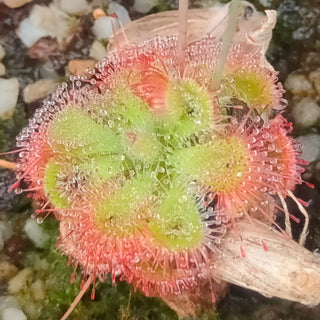Vaccinium arboreum
SPARKLEBERRY, FARKLEBERRY
- Unit price
- / per
Vaccinium arboreum (sparkleberry or farkleberry) is a species of Vaccinium native to the southeastern and south-central United States, from southern Virginia west to southeastern Nebraska, south to Florida and eastern Texas, and north to Illinois.
It is a shrub (rarely a small tree) growing to 3-5 m (7.5-12.5 feet) rarely 9 m) (22.5 feet) tall, with a diameter at breast height of up to 35 cm (14 inches). The leaves are evergreen in the south of the range, but deciduous further north where winters are colder.
Sparkleberry grows on sand dunes, hammocks, dry hillsides, meadows, and in rocky woods. It also grows on a variety of moist sites such as wet bottomlands and along creek banks.
The flowers are white, bell-shaped, and 3-4 mm (0.12-0.16 inches) in diameter. The fruit is a round dry berry about 6 mm (0.24 inches) in diameter, green at first, black when ripe, edible but bitter and tough. They are eaten by various wildlife.
Type: Perennial
Hardiness zones: 6-9
Location: Full sun
Height: 4m, 12'
Seeds per packet: 10
Soak the seeds for 12-24 hours before planting. Sow just under the surface of the soil and water in. Then cover them with plastic and place in a fridge for 90 days. Be sure they stay moist. After the cold stratification period they are then brought back to room temperature 20-22C (68-72F) for them to germinate. Germination is generally 30-90 days after the warming period, though some can take longer. Do not discard the planting tray, as patience is needed, and they are well worth the wait.
Vaccinium arboreum
SPARKLEBERRY, FARKLEBERRY
- Unit price
- / per
Multiple secure payment options available.
Adding product to your cart
You may also like
Vaccinium arboreum (sparkleberry or farkleberry) is a species of Vaccinium native to the southeastern and south-central United States, from southern Virginia west to southeastern Nebraska, south to Florida and eastern Texas, and north to Illinois.
It is a shrub (rarely a small tree) growing to 3-5 m (7.5-12.5 feet) rarely 9 m) (22.5 feet) tall, with a diameter at breast height of up to 35 cm (14 inches). The leaves are evergreen in the south of the range, but deciduous further north where winters are colder.
Sparkleberry grows on sand dunes, hammocks, dry hillsides, meadows, and in rocky woods. It also grows on a variety of moist sites such as wet bottomlands and along creek banks.
The flowers are white, bell-shaped, and 3-4 mm (0.12-0.16 inches) in diameter. The fruit is a round dry berry about 6 mm (0.24 inches) in diameter, green at first, black when ripe, edible but bitter and tough. They are eaten by various wildlife.
Type: Perennial
Hardiness zones: 6-9
Location: Full sun
Height: 4m, 12'
Seeds per packet: 10
Soak the seeds for 12-24 hours before planting. Sow just under the surface of the soil and water in. Then cover them with plastic and place in a fridge for 90 days. Be sure they stay moist. After the cold stratification period they are then brought back to room temperature 20-22C (68-72F) for them to germinate. Germination is generally 30-90 days after the warming period, though some can take longer. Do not discard the planting tray, as patience is needed, and they are well worth the wait.

















































